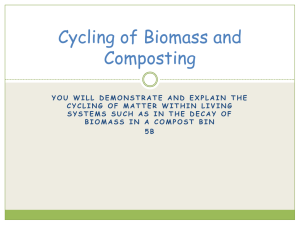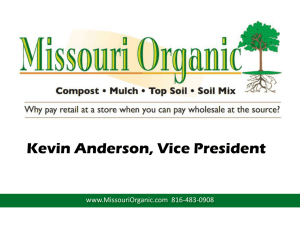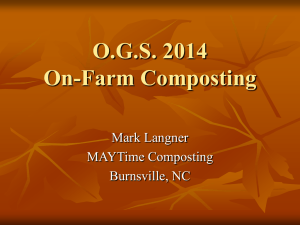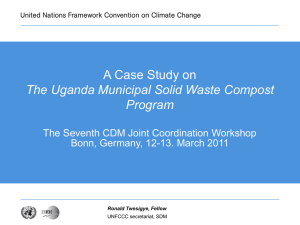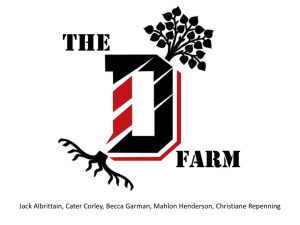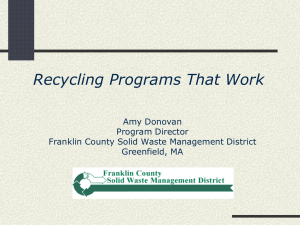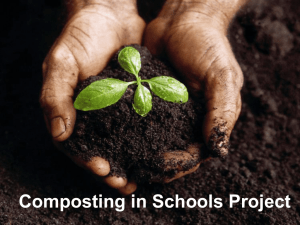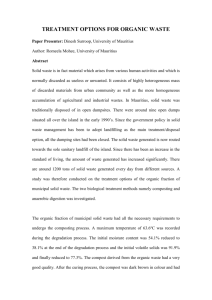Solid Waste Management in Indonesia
advertisement
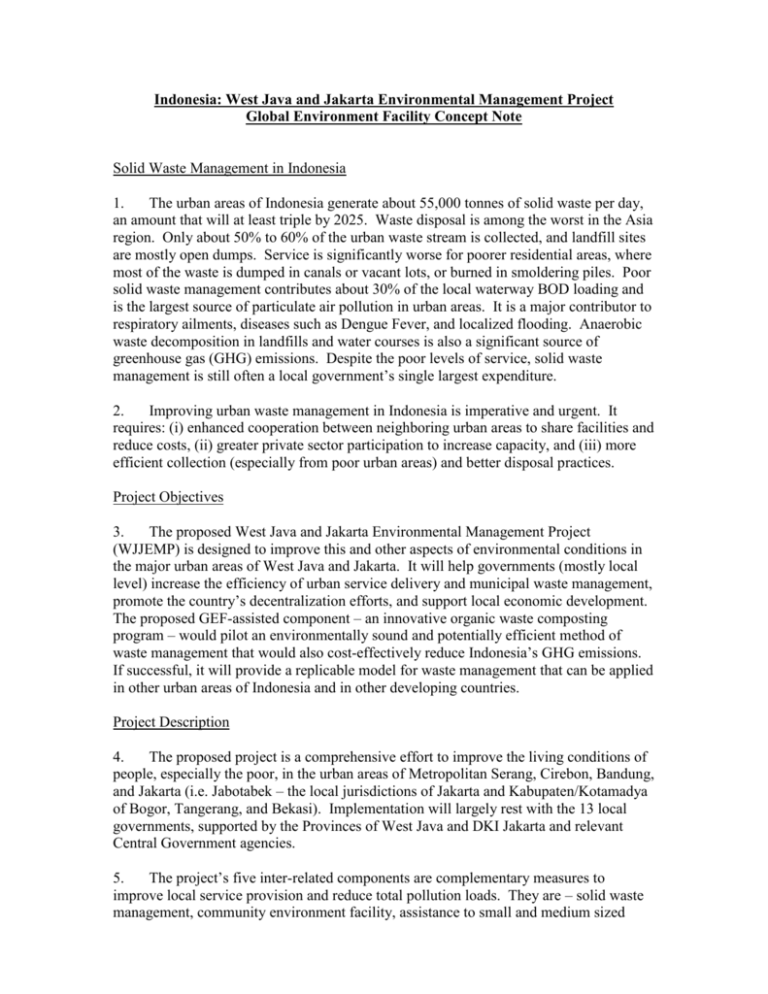
Indonesia: West Java and Jakarta Environmental Management Project Global Environment Facility Concept Note Solid Waste Management in Indonesia 1. The urban areas of Indonesia generate about 55,000 tonnes of solid waste per day, an amount that will at least triple by 2025. Waste disposal is among the worst in the Asia region. Only about 50% to 60% of the urban waste stream is collected, and landfill sites are mostly open dumps. Service is significantly worse for poorer residential areas, where most of the waste is dumped in canals or vacant lots, or burned in smoldering piles. Poor solid waste management contributes about 30% of the local waterway BOD loading and is the largest source of particulate air pollution in urban areas. It is a major contributor to respiratory ailments, diseases such as Dengue Fever, and localized flooding. Anaerobic waste decomposition in landfills and water courses is also a significant source of greenhouse gas (GHG) emissions. Despite the poor levels of service, solid waste management is still often a local government’s single largest expenditure. 2. Improving urban waste management in Indonesia is imperative and urgent. It requires: (i) enhanced cooperation between neighboring urban areas to share facilities and reduce costs, (ii) greater private sector participation to increase capacity, and (iii) more efficient collection (especially from poor urban areas) and better disposal practices. Project Objectives 3. The proposed West Java and Jakarta Environmental Management Project (WJJEMP) is designed to improve this and other aspects of environmental conditions in the major urban areas of West Java and Jakarta. It will help governments (mostly local level) increase the efficiency of urban service delivery and municipal waste management, promote the country’s decentralization efforts, and support local economic development. The proposed GEF-assisted component – an innovative organic waste composting program – would pilot an environmentally sound and potentially efficient method of waste management that would also cost-effectively reduce Indonesia’s GHG emissions. If successful, it will provide a replicable model for waste management that can be applied in other urban areas of Indonesia and in other developing countries. Project Description 4. The proposed project is a comprehensive effort to improve the living conditions of people, especially the poor, in the urban areas of Metropolitan Serang, Cirebon, Bandung, and Jakarta (i.e. Jabotabek – the local jurisdictions of Jakarta and Kabupaten/Kotamadya of Bogor, Tangerang, and Bekasi). Implementation will largely rest with the 13 local governments, supported by the Provinces of West Java and DKI Jakarta and relevant Central Government agencies. 5. The project’s five inter-related components are complementary measures to improve local service provision and reduce total pollution loads. They are – solid waste management, community environment facility, assistance to small and medium sized industries, environmental education, and local environmental management. The bulk of the investments will be devoted to improvements in solid waste management. 6. A key component of the project is establishment of the regional Jabotabek Waste Management Authority. Recent government legislation encourages the formation of these jointly owned and managed service provision agencies. Waste disposal is one of the most important public services that lends itself very well to regional collaborative action and planning. Current Waste Management Practice, Baseline Situation and GEF Alternative 7. Current Situation: About 50% to 60% of the urban waste stream is collected and dumped at basic landfills. Collection rates are lower in poor neighborhoods – Jakarta’s collection is estimated at 66% and Botabek’s only 23%. There is significant uncontrolled dumping and virtually no “sanitary landfilling”. The few existing disposal sites which could conceivably be operated as sanitary landfills are deficient in a number of areas, i.e. no daily waste covering, sporadic compaction, poor control of dumping and dangerous working conditions for waste pickers, ineffective leachate collection and treatment. A few waste disposal sites, such as Ciangir in Bali, have been operated close to sanitary landfill conditions. However, methane collection and flaring has not been attempted, and the cost and technology barriers it faces, such as seasonal variations in moisture and the relative sophistication of methane collection design and operating requirements mean that it is most unlikely to occur. An alternative means of reducing methane emissions separating organic and non-organic waste and composting the organic component - has been tried on a small scale in over 40 local areas, and a few such programs are still operating. Areas of high organic waste supply have been identified and many people are aware of composting and its potential role in an integrated waste management system. 8. Baseline: All levels of government within Indonesia recognize the environmental unsustainability of existing waste management programs and are attempting to remedy the situation. The proposed project is one example of government’s willingness to better manage solid waste. The project sets a goal for the Jabotabek urban region of 100% collection coverage and efficiency by 2010. The collected waste will be disposed of in sanitary landfills. However, it is unlikely that methane collection would be widespread, since most of the waste disposal would occur in existing sites where retrofitting for methane collection would be difficult (and flaring would be extremely difficult due to sporadic methane concentrations and inadequate capping). New landfill sites are proposed that could have methane collection. However, the prospects of flaring this gas (thereby reducing methane concentrations and overall GHG contributions) are highly uncertain. Although costs vary considerably between sites, it is estimated that the baseline (sanitary landfilling at existing and a few newly commissioned sites with no methane collection) costs an average of $25.00 per tonne of waste received on site. These costs will be financed by Indonesia. 9. GEF Alternative: Most efforts to reduce GHG emissions from municipal solid waste have focussed on methane collection at sanitary landfills and either flaring or use as a fuel. An alternative, less technically demanding and potentially more widely replicable way to reduce GHG emissions is to compost the organic fraction of the waste stream. Composting is an aerobic (with oxygen) degradation process and produces CO2 as a by-product, as opposed to the methane (CH4) that is produced from anaerobic decomposition (which occurs in landfills). Composting is a cost-effective way to reduce GHG emissions because: (a) The methane produced by anaerobic decomposition is a much more potent GHG than the CO2 produced by composting. Plus the best designed and operated landfill gas recovery systems (or anaerobic “fuel cells”) collect at most about 80% of the methane. (b) Composting occurs much closer to the waste generation source, thus reducing transportation costs and associated emissions. Composting also avoids the operation of landfill equipment. (c) Compost application reduces the need for synthetic fertilizers which involve an energy-intensive, and GHG contributing, manufacturing process. (Although compost only has a low fertilizer contribution, its ability to improve soil structure enables more efficient use of fertilizers). 10. Under the GEF alternative, communities in the Jabotabek region would compost an average of 100,000 tonnes/year of organic waste over the seven year life of the project and divert this waste from landfills, where it would decompose anaerobically. In so doing, the GEF alternative would reduce GHG emissions by about 600,000 tonnes of CO2 equivalent per year. The cost of the GEF alternative is about $40.00 per tonne of organic waste treated, which totals $28 million. Its incremental costs are $15.00 per tonne, and total $10.5 million. This equates to a unit abatement cost of $2.73/tonne of carbon equivalent. Consistency with the GEF’s Operational Strategy 11. The proposed project is fully consistent with the GEF’s criteria for Short Term Projects, which is the GEF eligibility window to which Indonesia wishes to apply. It is one of Indonesia’s nine top priority GHG abatement projects (ALGAS Report, pp 13 and 15). It is highly cost-effective, with a unit abatement cost of $2.73/tonne/carbon. It has good prospects of long-term sustainability and replication. The Proposed Organic Waste Composting System 12. Composting has been inhibited in Indonesia, and elsewhere, by two major barriers; technical and financial. To help overcome the technical barrier, draft compost guidelines have been prepared for Indonesia. These guidelines represent consistent but achievable quality standards (which are necessary for market development), and would enable Indonesia to develop a sustainable composting industry. Preliminary economic and financial assessments have been completed that highlight the benefits of composting and demonstrate its potential long-term financial viability. 13. To achieve long-term financial viability, composting must be practiced on a sufficient scale to mobilize local government financial support (from savings in waste collection and treatment) and to penetrate the commercial agricultural fertilizer market. According to the financial analysis, composting of at least 100,000 tonnes of waste per year is necessary to meet these conditions. The establishment of a large-scale composting system would be financed initially through three sources; local government budgetary provision (avoided disposal and transportation costs), compost sales, and compost credits to producers that would encourage them to learn the technique and adopt the practice over a seven-year period while a sustainable compost market is developed. Local government cost savings and compost sales would not be sufficient to support the initiative initially, but the system could be sustainable in the long term as the marketing system develops and as the savings to government become evident and more resources are allocated to solid waste management. To promote sustainability, the composting credits would decline over the component’s proposed seven year life. 14. The composting credits would be disbursed by the Jabotabek Waste Management Authority. This organization would develop the required professional capacity and be subject to fiduciary review by the World Bank. The credits would be disbursed per tonne of compost produced, which would be easily verifiable. Payment could be made per presented invoice and spot checks carried out to ensure corresponding compost activity. The use of compost credits is also a good way to promote private sector participation and encourage producers to find the optimum methods for compost production. For example, small scale composting activities would have equal access to the funds as larger municipal or private sector operated facilities. Jabotabek would offer composting producers assistance with marketing to the agricultural community, production advice, and access to the results of composting and compost use research. Suitability of the Project Site 15. Java is particularly suitable for testing waste composting on a large scale. Western Java is both one of the world’s most densely populated and intensively cultivated areas. (The project area encompasses some 25 million people who live within a 100 km-wide zone of intensive agriculture). About 60% of the urban waste stream is organic, and there is a virtually unlimited potential market for good quality compost, e.g. extensive dryland farming areas and urban agriculture activities. Indonesia’s climate is also optimum for composting. Of all the East Asian countries, Indonesia (and the Philippines) face the greatest challenge of increased waste generation and limited funds to address the issue. Stakeholder Involvement 16. The primary stakeholders are the millions of urban inhabitants who will benefit from the project’s waste management and other environmental improvements and who will participate in the organic waste composting component. Community representatives have been consulted on the project design and their experience with and attitudes to the proposed waste composting system by the local governments. As it is envisaged that women will play a major role in the waste composting scheme, community-based women’s organizations have been specifically targeted in the consultations. Issues/Risks 17. Among the major risks are: (i) professional performance of the Jabotabek Waste Management Authority, e.g. the speed with which it develops the necessary institutional capacity to manage the composting system; (ii) quality and marketability of the compost produced, (iii) verification of the compost that is produced; and (iv) sufficient diversion of organic material. Many of these risks would be mitigated by disbursing GEF funds against compost actually produced (with its corresponding global environmental benefit). World Bank User N:\GEF\Indonesia\WJJEMPConcept.doc 10/05/99 6:38 PM

